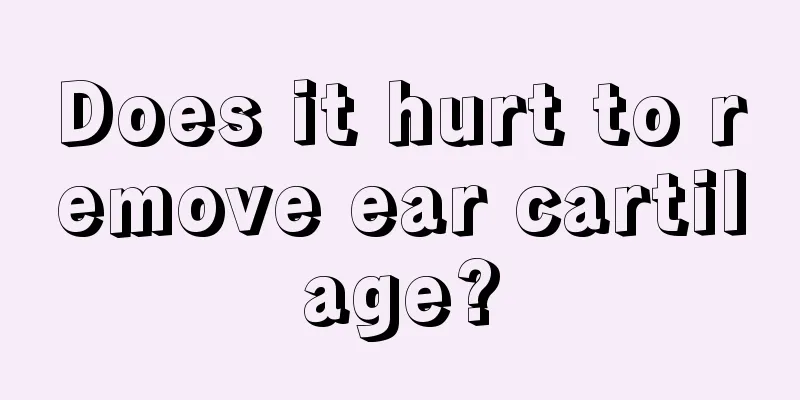Does it hurt to remove ear cartilage?

|
The ear is an indispensable part of the human body structure. I believe that anyone who has a certain understanding of the structure of the ear will know that the ear is mainly composed of some cartilage tissue. This leads to many people using some ear cartilage to fill their noses during daily plastic surgery to make their noses more straight and upturned. So will it feel very painful when removing ear cartilage? Let us find out through the following article. If the available septal cartilage has been exhausted, ear cartilage can provide a larger amount of cartilage tissue for rhinoplasty. Ear cartilage can be transplanted to the nose tip, nose dorsum, and nose wing contour, and can be used to reconstruct the outer and lower cartilage. However, because its tissue is relatively soft, it cannot be used for nasal support structures. There will be no obvious deformation or scar formation in the ear cartilage donor area. Cartilage was harvested through the preauricular approach for nasal tip transplantation and lateral lower cartilage reconstruction. 3 ml of 1% lidocaine solution containing 1:100,000 epinephrine can be injected on the surface of the cartilage to achieve the purpose of hemostasis and swelling stripping. Use a No. 15 blade to make a 3 mm incision in the skin along the inner side of the concha cavity, and use small scissors to peel off along the deep surface of the perichondrium. Use a No. 15 blade to cut the cartilage about 3 mm inside the edge of the concha and parallel to the edge of the concha, so that the integrity of the auricular cartilage can still be maintained. Use small scissors to peel back the concha cartilage behind the ear. Once the cartilage stripping is completed in all areas from the front to the back of the ear, the cartilage can be removed with a No. 15 blade. After hemostasis, the incision was sutured continuously with 5-0 sutures. Place cotton balls in front and behind the skin of the concha cavity and fix them with 3-0 nylon sutures to prevent the occurrence of hematoma. Remove the cotton balls 3 days after the operation. Obtaining ear cartilage If a longer, more plastic piece of auricular cartilage is desired, a retroauricular approach is usually used. First, inject local anesthetic into the area of auricular cartilage to be cut, that is, inject about 3 ml of 1% lidocaine solution containing 1:100,000 epinephrine into the superficial and deep layers of the auricular perichondrium. A 3 cm incision was made in the dorsal skin of the concha cavity with a No. 15 blade. After peeling from the skin to the perichondrium using small scissors, the deep and superficial layers of the perichondrium in the concha cavity were sharply peeled to the postauricular groove. A 25G needle dipped in methylene blue can be used to penetrate from the front to the back of the auricle to mark the range of cartilage removal. Care should be taken to preserve approximately 3 mm of concha cartilage, which is located along the concha above the crus of the antihelix and below the pretragus notch to prevent donor site deformity. Next, use a No. 15 blade to draw the outline of the required ear cartilage, and then use small scissors to peel off from the skin in front of the ear to the perichondrium, and then peel sharply on the deep surface of the perichondrium of the concha cavity. Once the desired cartilage has been separated from the preauricular and postauricular skin, the auricular cartilage is harvested using a No. 15 blade. After hemostasis, the skin incision was sutured continuously with 5-0 normal gut. The concha cavity is also compressed and fixed with cotton balls and fixed with 3-0 nylon thread to prevent the occurrence of hematoma. |
<<: Does it hurt to pull out your nails?
>>: Does it hurt to get a clavicle tattoo
Recommend
What are the methods to prevent rectal prolapse
If rectal prolapse is not effectively relieved, i...
What are the symptoms of advanced liver cancer? 4 symptoms indicate that liver cancer has reached an advanced stage
In general, the symptoms of liver cancer are not ...
Pain when swallowing on the right side of your throat?
Pain in the throat when swallowing may be caused ...
Exercise guidance for people with teratoma
Teratoma is closely related to daily life, so you...
Effects and precautions of fumigation with pepper water
Sichuan pepper has the effects of analgesia, anti...
The difference between light dried sea cucumber and salt dried sea cucumber, teach you how to choose sea cucumber
Sea cucumbers are seafood with high nutritional v...
Can an inflamed ear piercing heal itself?
Ear piercing is prone to infection. In the summer...
Does nasopharyngeal cancer cause runny nose?
Doesn’t nasopharyngeal cancer cause a runny nose?...
What fruits are good for acute gastroenteritis
For acute gastroenteritis, food should of course ...
Pain in the middle of the calf bone
The pain in the middle of the calf bone is relate...
My eyes itch and a swell up when I rub them
Eyes are one of our five senses and play an impor...
The dangers of double eyelid surgery, these must be paid attention to
It is understandable that people get double eyeli...
What should glioma patients pay attention to in their diet
As the saying goes, disease comes from the mouth,...
What are the hazards of water heating blankets and what should you pay attention to when using them
Every winter is so cold that people have to think...
Six dietary principles for colorectal cancer
Colorectal cancer is a common malignant tumor of ...









